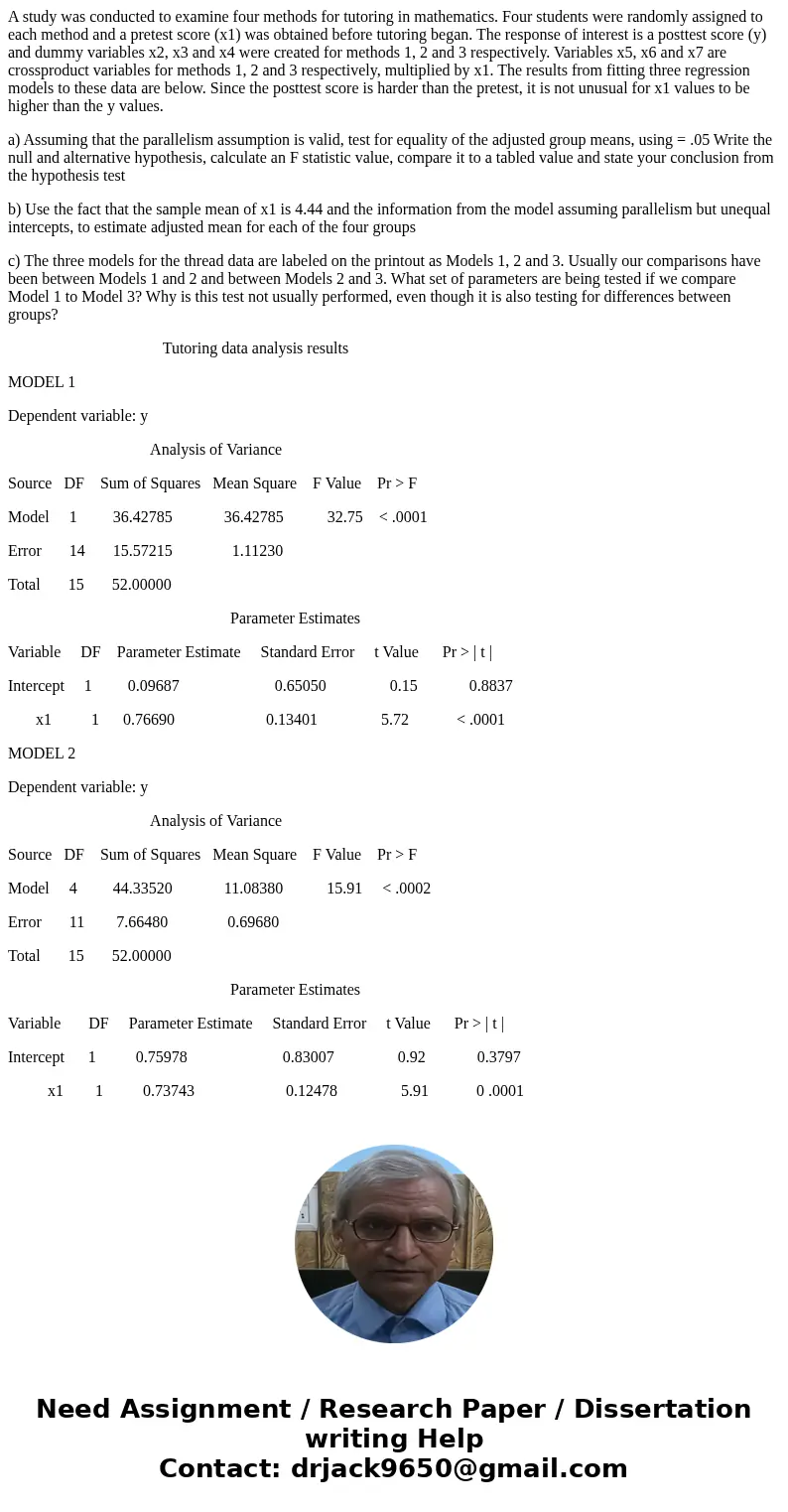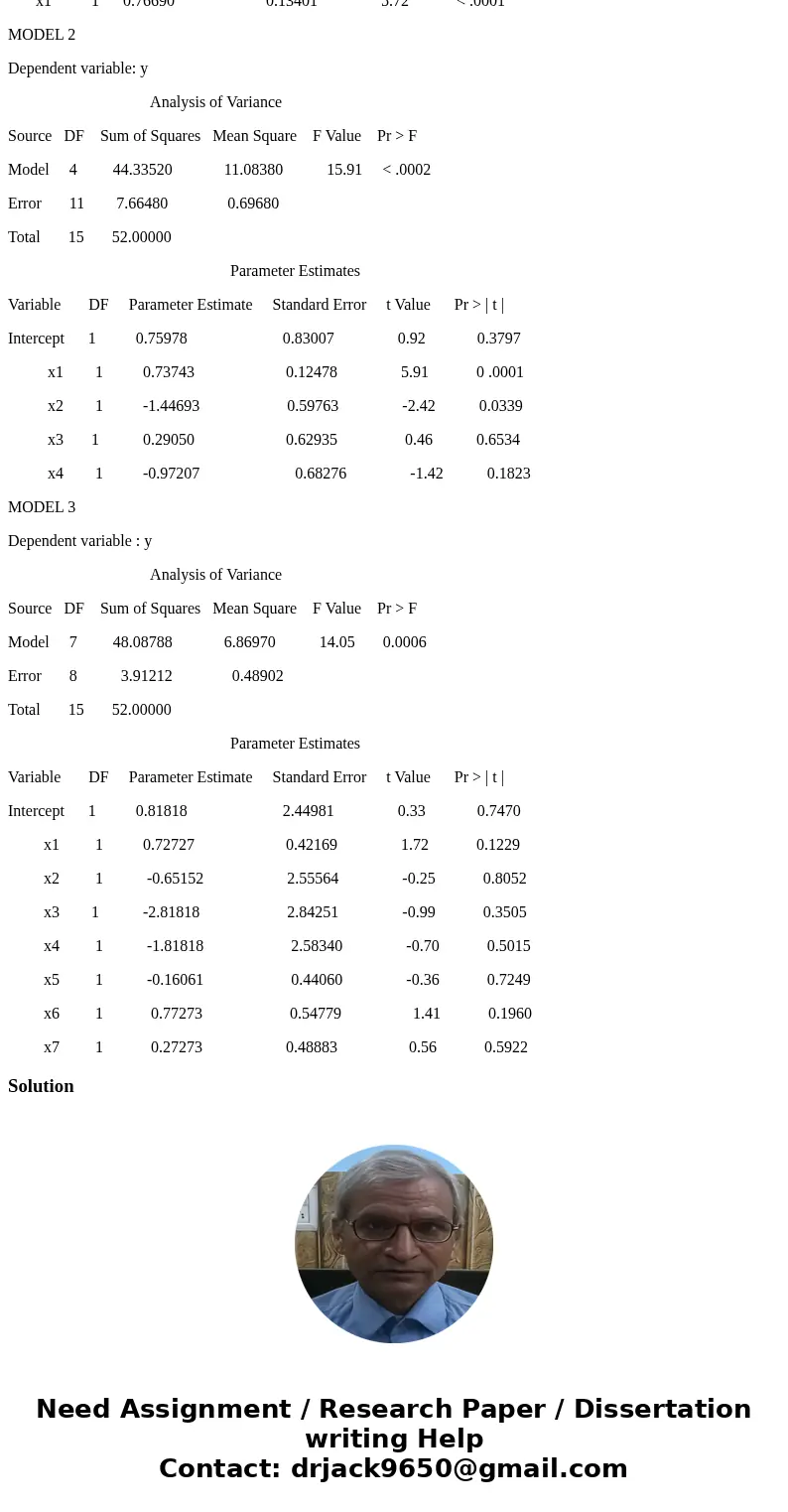A study was conducted to examine four methods for tutoring i
A study was conducted to examine four methods for tutoring in mathematics. Four students were randomly assigned to each method and a pretest score (x1) was obtained before tutoring began. The response of interest is a posttest score (y) and dummy variables x2, x3 and x4 were created for methods 1, 2 and 3 respectively. Variables x5, x6 and x7 are crossproduct variables for methods 1, 2 and 3 respectively, multiplied by x1. The results from fitting three regression models to these data are below. Since the posttest score is harder than the pretest, it is not unusual for x1 values to be higher than the y values.
a) Assuming that the parallelism assumption is valid, test for equality of the adjusted group means, using = .05 Write the null and alternative hypothesis, calculate an F statistic value, compare it to a tabled value and state your conclusion from the hypothesis test
b) Use the fact that the sample mean of x1 is 4.44 and the information from the model assuming parallelism but unequal intercepts, to estimate adjusted mean for each of the four groups
c) The three models for the thread data are labeled on the printout as Models 1, 2 and 3. Usually our comparisons have been between Models 1 and 2 and between Models 2 and 3. What set of parameters are being tested if we compare Model 1 to Model 3? Why is this test not usually performed, even though it is also testing for differences between groups?
Tutoring data analysis results
MODEL 1
Dependent variable: y
Analysis of Variance
Source DF Sum of Squares Mean Square F Value Pr > F
Model 1 36.42785 36.42785 32.75 < .0001
Error 14 15.57215 1.11230
Total 15 52.00000
Parameter Estimates
Variable DF Parameter Estimate Standard Error t Value Pr > | t |
Intercept 1 0.09687 0.65050 0.15 0.8837
x1 1 0.76690 0.13401 5.72 < .0001
MODEL 2
Dependent variable: y
Analysis of Variance
Source DF Sum of Squares Mean Square F Value Pr > F
Model 4 44.33520 11.08380 15.91 < .0002
Error 11 7.66480 0.69680
Total 15 52.00000
Parameter Estimates
Variable DF Parameter Estimate Standard Error t Value Pr > | t |
Intercept 1 0.75978 0.83007 0.92 0.3797
x1 1 0.73743 0.12478 5.91 0 .0001
x2 1 -1.44693 0.59763 -2.42 0.0339
x3 1 0.29050 0.62935 0.46 0.6534
x4 1 -0.97207 0.68276 -1.42 0.1823
MODEL 3
Dependent variable : y
Analysis of Variance
Source DF Sum of Squares Mean Square F Value Pr > F
Model 7 48.08788 6.86970 14.05 0.0006
Error 8 3.91212 0.48902
Total 15 52.00000
Parameter Estimates
Variable DF Parameter Estimate Standard Error t Value Pr > | t |
Intercept 1 0.81818 2.44981 0.33 0.7470
x1 1 0.72727 0.42169 1.72 0.1229
x2 1 -0.65152 2.55564 -0.25 0.8052
x3 1 -2.81818 2.84251 -0.99 0.3505
x4 1 -1.81818 2.58340 -0.70 0.5015
x5 1 -0.16061 0.44060 -0.36 0.7249
x6 1 0.77273 0.54779 1.41 0.1960
x7 1 0.27273 0.48883 0.56 0.5922
Solution


 Homework Sourse
Homework Sourse